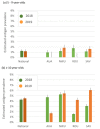Evaluating Molecular Xenomonitoring as a Tool for Lymphatic Filariasis Surveillance in Samoa, 2018-2019
- PMID: 36006295
- PMCID: PMC9414188
- DOI: 10.3390/tropicalmed7080203
Evaluating Molecular Xenomonitoring as a Tool for Lymphatic Filariasis Surveillance in Samoa, 2018-2019
Abstract
Molecular xenomonitoring (MX), the detection of filarial DNA in mosquitoes using molecular methods (PCR), is a potentially useful surveillance strategy for lymphatic filariasis (LF) elimination programs. Delay in filarial antigen (Ag) clearance post-treatment is a limitation of using human surveys to provide an early indicator of the impact of mass drug administration (MDA), and MX may be more useful in this setting. We compared prevalence of infected mosquitoes pre- and post-MDA (2018 and 2019) in 35 primary sampling units (PSUs) in Samoa, and investigated associations between the presence of PCR-positive mosquitoes and Ag-positive humans. We observed a statistically significant decline in estimated mosquito infection prevalence post-MDA at the national level (from 0.9% to 0.3%, OR 0.4) but no change in human Ag prevalence during this time. Ag prevalence in 2019 was higher in randomly selected PSUs where PCR-positive pools were detected (1.4% in ages 5-9; 4.8% in ages ≥10), compared to those where PCR-positive pools were not detected (0.2% in ages 5-9; 3.2% in ages ≥10). Our study provides promising evidence for MX as a complement to human surveys in post-MDA surveillance.
Keywords: elephantiasis; entomology; molecular xenomonitoring; neglected tropical diseases; vector-borne disease.
Conflict of interest statement
The authors declare no conflict of interest.
Figures







Similar articles
-
Molecular xenomonitoring as an indicator of microfilaraemia prevalence for lymphatic filariasis in Samoa in 2019.Parasit Vectors. 2024 Sep 9;17(1):382. doi: 10.1186/s13071-024-06463-7. Parasit Vectors. 2024. PMID: 39252131 Free PMC article.
-
Lymphatic Filariasis Elimination in American Samoa: Evaluation of Molecular Xenomonitoring as a Surveillance Tool in the Endgame.PLoS Negl Trop Dis. 2016 Nov 1;10(11):e0005108. doi: 10.1371/journal.pntd.0005108. eCollection 2016 Nov. PLoS Negl Trop Dis. 2016. PMID: 27802280 Free PMC article.
-
Molecular xenomonitoring as a post-MDA surveillance tool for global programme to eliminate lymphatic filariasis: Field validation in an evaluation unit in India.PLoS Negl Trop Dis. 2020 Jan 24;14(1):e0007862. doi: 10.1371/journal.pntd.0007862. eCollection 2020 Jan. PLoS Negl Trop Dis. 2020. PMID: 31978060 Free PMC article.
-
Evaluating the Diagnostic Test Accuracy of Molecular Xenomonitoring Methods for Characterizing Community Burden of Lymphatic Filariasis.Clin Infect Dis. 2021 Jun 14;72(Suppl 3):S203-S209. doi: 10.1093/cid/ciab197. Clin Infect Dis. 2021. PMID: 33906238 Free PMC article.
-
Prospects, drawbacks and future needs of xenomonitoring for the endpoint evaluation of lymphatic filariasis elimination programs in Africa.Trans R Soc Trop Med Hyg. 2016 Feb;110(2):90-7. doi: 10.1093/trstmh/trv104. Trans R Soc Trop Med Hyg. 2016. PMID: 26822601 Review.
Cited by
-
Recurrence of microfilaraemia after triple-drug therapy for lymphatic filariasis in Samoa: Recrudescence or reinfection?Int J Infect Dis. 2025 Mar;152:107809. doi: 10.1016/j.ijid.2025.107809. Epub 2025 Jan 30. Int J Infect Dis. 2025. PMID: 39892502 Free PMC article.
-
Mini-TAS as a confirmatory mapping tool for remapping areas with uncertain filarial endemicity to exclude/ include for mass drug administration: A report from field validation in India.PLoS One. 2023 Nov 3;18(11):e0293641. doi: 10.1371/journal.pone.0293641. eCollection 2023. PLoS One. 2023. PMID: 37922274 Free PMC article.
-
The impact of mosquito sampling strategies on molecular xenomonitoring prevalence for filariasis: a systematic review.Bull World Health Organ. 2024 Mar 1;102(3):204-215. doi: 10.2471/BLT.23.290424. Epub 2023 Dec 8. Bull World Health Organ. 2024. PMID: 38420575 Free PMC article.
-
Reactive case detection can improve the efficiency of lymphatic filariasis surveillance compared to random sampling, Samoa 2023.PLoS Negl Trop Dis. 2025 Jul 11;19(7):e0012622. doi: 10.1371/journal.pntd.0012622. eCollection 2025 Jul. PLoS Negl Trop Dis. 2025. PMID: 40644410 Free PMC article.
-
Ongoing transmission of lymphatic filariasis in Samoa 4.5 years after one round of triple-drug mass drug administration.PLoS Negl Trop Dis. 2024 Jun 27;18(6):e0012236. doi: 10.1371/journal.pntd.0012236. eCollection 2024 Jun. PLoS Negl Trop Dis. 2024. PMID: 38935622 Free PMC article.
References
-
- Weil G.J., Curtis K.C., Fakoli L., Fischer K., Gankpala L., Lammie P.J., Majewski A.C., Pelletreau S., Won K.Y., Bolay F.K., et al. Laboratory and field evaluation of a new rapid test for detecting wuchereria bancrofti Antigen in human blood. Am. J. Trop. Med. Hyg. 2013;89:11–15. doi: 10.4269/ajtmh.13-0089. - DOI - PMC - PubMed
-
- Rao R.U., Samarasekera S.D., Nagodavithana K.C., Goss C.W., Punchihewa M.W., Dassanayaka T.D.M., Ranasinghe U.S.B., Mendis D., Weil G.J. Comprehensive Assessment of a Hotspot with Persistent Bancroftian Filariasis in Coastal Sri Lanka. Am. J. Trop. Med. Hyg. 2018;99:735–742. doi: 10.4269/ajtmh.18-0169. - DOI - PMC - PubMed
Grants and funding
LinkOut - more resources
Full Text Sources

